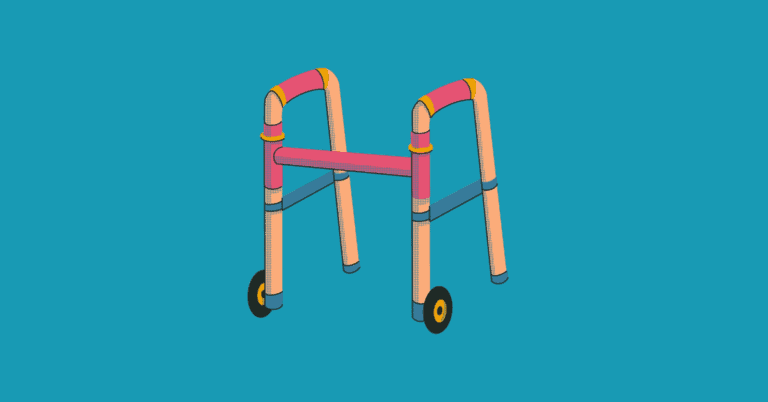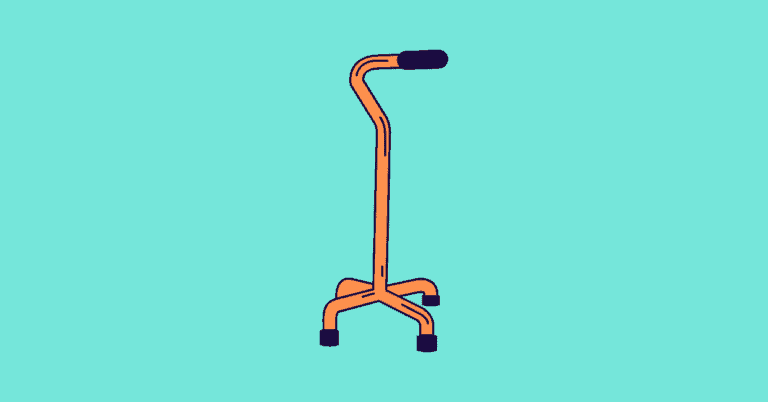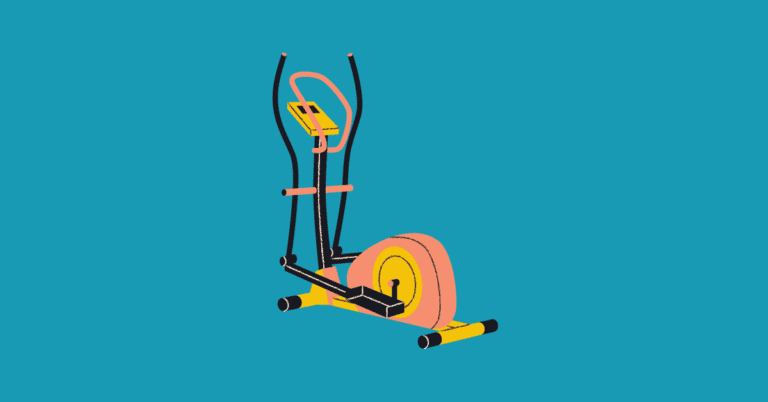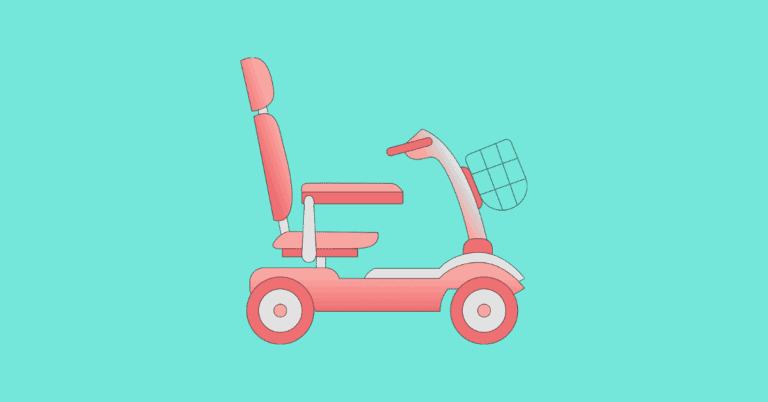What Is A 3 Wheel Walker (Rollator): Pros And Cons
Three wheel rolling walkers are officially referred to as “three wheel rollators” because these assistive devices have wheels on all three “legs” or bases. So for the purposes of this article, three wheel rolling walkers are the same as three wheel rollators.
A 3 wheel walker, or 3 wheel rollator is a walking aid used to provide stability and support for individuals with who may have difficulty walking independently or are at increased falls risk.
Different from a standard rollator, a three wheel rollator has a conical shape at the front with one wheel in the front and two in the back.
3 wheel walker/rollator pros
Great for navigating narrow spaces
This is one of the biggest advantages noted by users. By design, a three wheel rollator is great for navigating tight spaces and corners, which makes it particularly well-suited for indoor-use.
Lightweight
Most of these rollators are constructed with a lightweight aluminum frame, which makes it easy to handle and transport. Since they are crafted with fewer materials compared to standard rollators, this also contributes to their overall lighter weight.
Easy to fold and compact
Most models are equipped with a knob at the top, which enables you to bring the handles together and collapse the rollator – making folding relatively easy. The compact design also adds to the ease of portability.
Include brakes system
The most commonly seen brakes system is the locking hand brakes, or loop-hand brakes (displayed below) for safety. These brakes function much like those on a bicycle: to brake while walking, you pull the brakes up. To temporarily secure the rollator, such as when taking a break or preparing to stand up, simply push the brakes down; this action should lock the wheels, and hence the rollator in place.
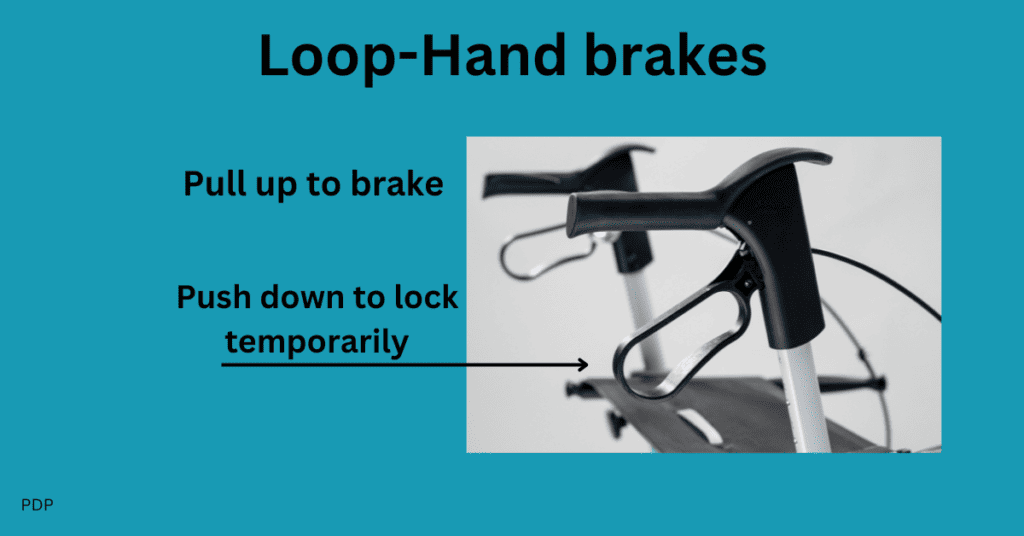
3 wheel walker/rollator cons
No seat
Unlike standard rollators, three wheel rollators generally do not come with a built-in seat due to their design. This might be particularly disadvantageous to individuals that require frequent rest breaks during walking.
Less stable than standard rollator
With the three wheel model, they may not offer the same stability as a standard four wheel rollator, particularly on outdoor terrain with inclines or uneven surfaces. If you require extra support or anticipate encountering challenging terrain, a four-wheel rollator might be a better option.
While a three-wheel rollator is still usable outdoors, it’s important to consider your specific needs. If your rollator is mainly for indoor use but you occasionally venture outdoors, a three-wheel model can still serve you well. However, for those who spend extended periods outside or engage in activities like hiking or long walks, a four-wheel rollator might offer better stability.
Are three wheel rollators better than other types of rollators and walkers?

Just like a three wheel rollator, every rollator model has its own advantages and disadvantages. As shown above, the three-wheeled rollator does stand out for its ability to allow easy maneuverability in navigating narrow space and corners. If this is a priority for you, then this is a great option.
Regardless, if you have concerns about your level of stability or balance, I recommend consulting with a healthcare professional for further guidance. They can provide personalized advice to ensure you select the most suitable mobility aid for your specific needs and priorities.
Features to consider in a three wheel rollator
Weight capacity
Manufacturers include the weight capacity in the description so make sure you are within the range. Most models tend to have weight capacity ranging from 250 to 300 pounds.
Convenient storage options for personal items
Most models come with either a storage bag or basket.
Wheel size
Wheel size can range from 6 to 10 inches. Smaller wheels are more suitable for indoor environments because they have a tiger turn radius which allows navigating narrow hallways and cramped spaces easier. On the other hand, rollators equipped with larger wheels, though they have a larger turn radius, are more suitable for ambulating in outdoor environments. Larger wheels are better at handling rough and uneven terrain.
The choice between smaller or larger wheels depends on your individual requirements and the intended usage scenarios, whether primarily indoors or outdoors.
Height adjustability
You want to check the range of the height adjustable handles to ensure it will fit your height. The general guideline that you want the handle height to be at a level that causes a slight bend in the elbow during use.
What are other options for assistive devices?
- Cane – Canes offer assistance to individuals requiring moderate to minimal support while walking or navigating uneven surfaces. They are frequently employed to enhance balance, relieve pain (for instance, in those with arthritis), or provide additional support to a weaker leg.
- Wheel walker – A wheel rolling walker is commonly used during recovery after lower limb surgery or injury. It’s also an option for those seeking intermittent assistance throughout the day, given its lightweight design and ease of folding and storage
- Standard rollator- A standard rollator, equipped with four wheels is a great choice for individuals at an increased risk of falls or those dealing with balance and stability issues, providing added security to prevent fall-related injuries. Moreover, a rollator with a seat can be beneficial for individuals with limited walking endurance, offering the convenience of taking seated rest breaks as needed.
- Upright Rollator – Similar to a standard rollator but an upright rollator is designed to encourage a more upright posture during use with higher-positioned arms rests.
Bottomline
To sum up, the three-wheel rollator is a mobility aid that stands out for its great maneuverability in tight spaces, making it perfect for navigating indoor environments.
If you have any concerns regarding your stability or balance, don’t hesitate to seek guidance from a healthcare professional.
